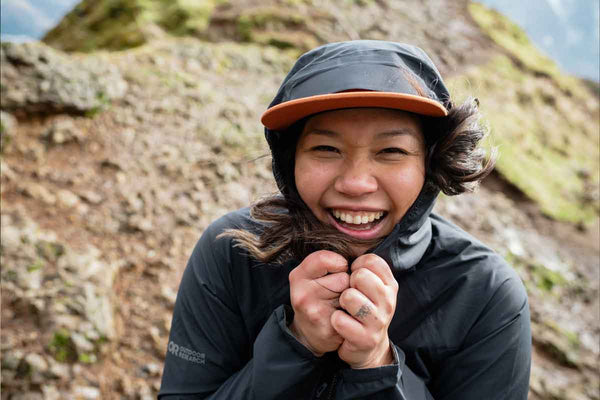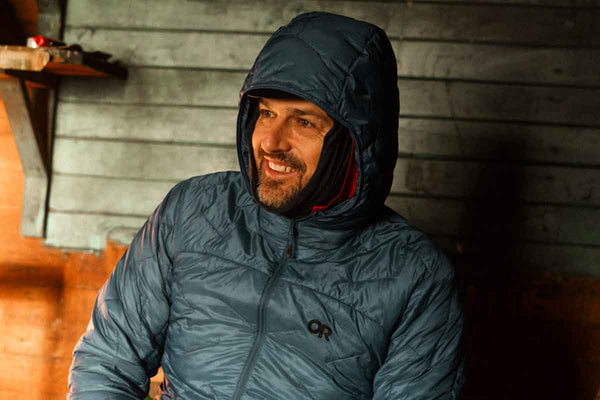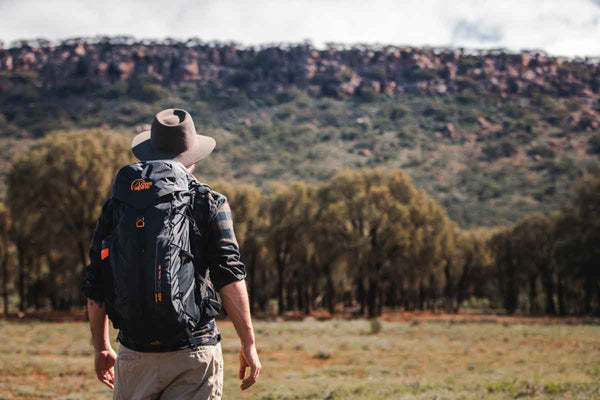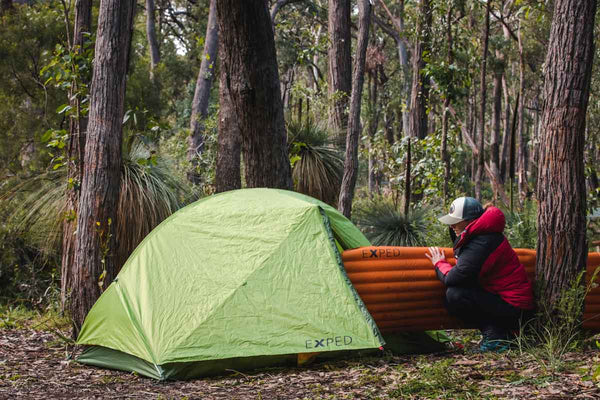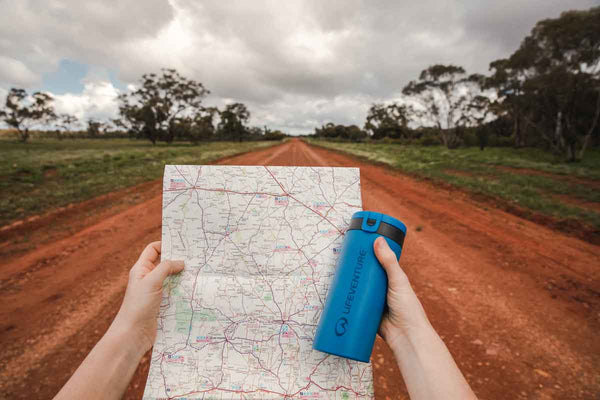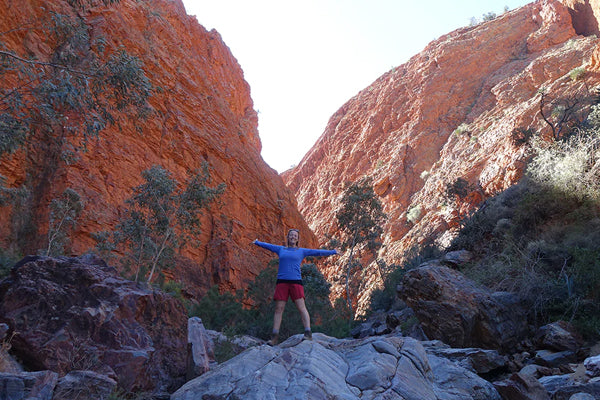
Trek & Travel's 12 most asked questions about the Larapinta Trail - Answered!
With boss-man Jemima having just returned from her solo end-to-end hike of the Larapinta Trail, we're in a great position to spill all the beans (figuratively) on this amazing hike. So, we put out the call for questions and here is Jemima's comprehensive list of answers to everything we were asked. If you're planning the 'pinta for next winter, we're all the info you need.

What direction is the best? What’s the best time of year to go?
Call me biased but from Alice to Redbank is of course the BEST direction. This was the way the track was designed. Starting from Alice you get the first 3 sections done with first, which are arguably the least inspiring. So why wouldn’t you want to get that over and done with at the beginning? Well for me I thought the first part was fantastic because I didn’t know what I was in for later! Ignorance was bliss in my case.
The only argument I can see for walking the other direction is that you don't have to arrange a pickup to get back to Alice, although some people do hitchhike back from Redbank Gorge and seem to have no problem. Sun in the morning or the afternoon? If you walk west then you’ll have the sun at your back in the morning rather than walking into it, which I preferred, but that would vary depending on your walking schedule.
Another argument for the west to east is that you get to walk AWAY from Alice Springs, away from civilisation, away from the city and the traffic and all the people. You walk into the wilderness, into the desert and once you get your sights on Mount Sonder those last few days seeing it coming closer and closer is such a magical experience.
What's a good daily average to aim for?
This is a really good question and one I had to predetermine before booking my pickup at the end of the trail. I discussed it with a colleague who did it in 14 days and said they felt a little rushed. A few guide books suggest 21 days but many of those only covered around 10km per day - a little too cruisey for me. I went with a happy medium and I settled on 17 days, which meant I’d be averaging around 15km a day.
Walking at this pace was satisfying for me. Sure, you can march it in 6-9 days if your ego pushes you, or you can really take your time and soak it all up over 3 weeks. I was, to be honest, a little quick to get through my kilometres each day and I would often find myself at the camp early. Then again, this gave me an opportunity to sit and reflect. I also had the chance to do all the side trips and get in early each day that I had a food drop to sort out my gear, swim and shower.

How did you organise the nitty gritty?
Food for 17 days! The mind boggles. For a single millennial who doesn’t cook and lives in a city with 30 cafes in a radius of 2 blocks - food always at my fingertips - I really struggled comprehending the organisation of my food. I wrote many lists and had a massive spreadsheet. Food, weights, kilometres, water tank locations, so many factors!
I wasn’t about to carry 17 days of food so I opted to split most of it into three resupply boxes along the way. I looked up a few companies that offered this service and settled on Larapinta Trail Trek Support or LTTS. They took a few days to get back to me, which made me a little nervous, but turns out they’re a two-person team so they’re often out on the road helping walkers. So if you make an enquiry with them and don't get an immediate response, don't despair, what they lack in response time they make up a hundred fold for their incredible 24/7 service while you’re actually on the track.
They come to your hotel the afternoon before you start with 3 boxes labelled with the locations from which you’ll be picking them up, the key for the sheds that the boxes are stored in, a Personal Locator Beacon (PLB), 4 gas canisters, and they confirm your pickup day at the far end. They can offer way more support if you require, e.g. if you wanted to skip a section, wanted to finish early, or if you needed something put in your resupply that you'd forgotten. I heard of them sourcing medicinal creams from the chemist for some hikers, and one guy who forgot his head torch was able to get a new one put into his resupply box. Oh, and my favourite part of the service was ditching stuff that I didn’t need in the resupply boxes, particularly rubbish, but also extra socks, rain gear, extra food etc.

How do you get water on the track and how much water will I need to carry each day?
Where: There are quite a few water tanks along the way. The longest distance between them is over 30km, otherwise you’ll usually pass at least one or two a day. These are monitored by rangers during the peak season to make sure none go dry. When they get low a tank with town water comes in to fill them up. Signs say you must treat the water, but I didn’t and I didn’t have a problem, then again I have travelled a lot in India so I might have a superhuman stomach.
There are very occasional watering holes, affectionately known as puddles by those who’d seen them. I had a Lifestraw to drink directly from them. The watering holes are super rare and not to be relied on.
How much: The first day walking the Larapinta I met a guy heading in the opposite direction who asked me how many litres I had. I told him "3 at the moment but I’ve got the ability to carry up to 6.5". He scoffed and said, “Ppffttt, you’ll only ever need TWO!” Not sure why he assumed he had the authority to decide on my hydration requirements, I mean I often drink 2L of water when I’m just sitting in an office. He might be a camel but I am certainly not! I thanked him for his uninvited advice and continued on my way.
How much water you need on the track really depends on the individual. If you don’t drink much water during the day and you plan to camp exclusively at the sites with water tanks, sure maybe 2L would be enough, but I wouldn’t recommend it. The time of the day you’re most active will also play a part. If you get up at 4am and hike only in the cool of the morning, you probably won’t drink as much water. But would you be willing to risk it? I’m a late starter in the mornings, leaving camp around 9am and taking my time. This meant I’d often be walking well into the midday and afternoon heat. On longer, hotter days I’d get through 3.5L.
Where you plan to camp will also factor into your water system. At least a third of the nights I camped away from water sources, either on a lookout or bluff or down on a riverbed (don’t be fooled by the name, there's no water in most of the river beds). For nights at dry camps there are a few things to consider: A) How much water you need to hike there, B) How much water you need to make dinner, brush your teeth, wash your hands and face, C) How much water you need for coffee in the morning (the most important part of the day) and breakfast and finally D) How far is it the next day to the next water tank?
I worked out this comes to roughly 6.5L maximum. You might need more, you might need less. If you take soft flask water containers at least you have the option to fill them without any excess weight or bulk.

Are there any river crossings?
There are loads and LOADS of river crossings, in fact there are whole days of walking along or crossing rivers and creeks. Is there any water in those rivers? NO, not a drop. At least when I was there (in August, the end of the dry season). Obviously if you heading there in the wet season (are you mad?!?) there will be more water about.
Was there any wildlife? Are there any dangerous animals?
I had all sorts of wild ideas about the wildlife on the Larapinta, such as snake bites and dingoes stealing my pack while I slept. Knowing the Aussie outback I expected it to be packed with loads of deadly creatures out to get me.
Honestly I didn’t see a single snake. Not enough water around would be my guess, and I didn’t see any dingoes, although I did spot some dingo prints around my tent one morning that weren’t there when I set up. I did see a few stunning parrots and plenty of crows, or were they ravens? Those big black noisy birds that (and I’ve witnessed this) have the ability to open pack buckles and will happily unpack your bag for you.
Apart from the flies *OH MAN, THE FLIES!*, there were no creepy crawlies out to get me. No mozzies, and I didn’t see a single spider. I ended up confidently sleeping out under the stars a couple of nights, no problemo.

Is the Larapinta tough on gear?
YES! The landscape is rough on gear. I’ve had to say farewell to a pair of my favourite leggings after getting holes from sitting on the rocks and walking through spinifex. But the track itself is tough on your body so saving weight is a BIG incentive.
I met with one couple who had the ultimate in lightweight gear but they found it so hard to pitch their tent on the rock solid ground they ended up spending the whole trek on the ground sheet sleeping under the stars. I had a super-tough One Planet Goondie 1 tent with a 100D Nylon base - no need for a ground sheet and free-standing so I could move it about if I found a better spot. I confidently set this up on any surface (apart from directly on spinifex, obviously!) and it was great for both the sandy spots and the hard rocky parts.
At the end of the day if you’ve got lightweight gear and you know how to take care of it, go for it! The lighter the better, but going lighter will mean potentially more repairs on the track.
What the number one thing you’re glad you took?
One THING!?!? Don’t make me chose! I’ll be really practical and say sun protection: hat, sunnies, long sleeve high UV top & sunscreen! (yeah, yeah I know that's more than one thing!)

Top gear you can’t survive without?
Ok, I like this question better. During the day I could not live without my hydration system! A Camelbak 3L bladder to sip at constantly while walking, my smaller Nalgene bottle with Nuun electrolytes to replace all the salts I was sweating out, and my Source 2L flat pack bottle for extra carrying capacity for those longer times between water tanks.
Meal times: I love love LoOoOOooooVe my Jetboil Minimo. I am NOT a morning person and I love that I can literally roll over, unzip my tent and make a coffee, still snuggled up in my sleeping bag. Because it's the fastest and most efficient way to boil water I didn’t have to carry much fuel either (100g gas canister every 4-5 days).
Atka Pocket drop: to dump my gear on without everything constantly getting covered in the red stuff. Also makes a cute little picnic blanket and welcome mat at the entrance to my tent.
Sleep: Man OH MAN I LOVE my sleep. OK first up, One Planet Bungle -4 sleeping bag “But Jemima,” I hear you ask, “minus 4 degrees? Isn’t that for the really cold?” YES it is and YES it was damn cold at night, especially around 4.30am in those last few hours before the sun came up. Brrrrr! Anytime I was up to watch the sunrise from on top of a lookout I’d find my perfect sitting stone and huddle in my sleeping bag wrapped up around my coffee against the bitter wind to watch that rich orange ribbon appear across the horizon. Purrrfect! A PILLOW is a total must and they’re crazy small and crazy comfy these days. Finally, my Sea To Summit Insulated Ultralight sleeping mat. These have sometimes had a bad rap for being noisy - PISH POSH I say to that! Nothing but sweet comfy dreams.
Camp Sandals!!! Oh the joys of taking off your boots at the end of the day and sliding them into camp sandals. Is there anything better? On the subject of feet, my Injinji liners were a godsend too!
Walking poles. OH MAN, these guys saved my bacon! Hours of walking along creek beds over unstable rocks, many times I would misjudge a rock and it would roll, my ankle rolling with it. With the Leki Micro Vario Carbon Poles I was able to quickly transfer load onto my arms to prevent serious injuries on a daily basis.
What's something you took that you didn’t need?
RAIN GEAR! Don’t take this as advice and not take any rain gear as this was a pretty dry year for rain, and in a dry time of year as well, but I never used mine. I asked a local beforehand if he knew whether it would rain and he responded with, “Well, it is forecast to rain”. “REALLY?” I said, shocked. Did he know something I didn’t? “When?” I asked. “Yeah…. March,” he laughed. Don’t take this as gospel though - please be prepared for all weather conditions.
I ended up ditching a fair amount of gear. Contentiously I dumped my gaiters; yeah they're good to keep stuff out of your boots and to stop the spinifex from scratching up your legs but I was WAY too hot in them and my skin did not react well. I didn’t need a towel either. I swam every opportunity I could: Ellery Creek, Ormiston Gorge, Finke River, Glen Helen and Red Bank. The water was unbearably cold but the moment you’re out and back in the sun you’re bone dry in just 10-15 mins.

Keeping clean, how do you deal with hygiene?
Such a great question and one I asked myself before I went. There are a few showers - Standley Chasm, Ellery Creek, and Ormiston Gorge all have hot showers. In between the official shower locations there are water tanks. Now keep in mind that water is scarce and it's a big effort for the rangers to refill these tanks so I certainly don't advocate you take a massive bath at each water tank, but there are ways to have a quick clean that doesn’t waste water.
Here’s what I do: With a bit of Sea to Summit Wilderness Wash in an Exped dry bag, add about 2 cups of water. I’d find a semi-secluded area and dunk my Buff into the slightly soapy mix to wash my face, arms, body etc. With the remaining water I’d throw my Buff, socks, undies and t-shirt into the dry bag, seal it up and give it a good shake. Drain the water (away from any natural water sources), wring out my clothes and hang off a tree or my tent guy ropes. The Wilderness Wash doesn’t require rinsing off body or clothes (bonus!) BOOM! You and your gear are clean!
Don’t bother taking dry shampoo, honestly the dust does the exact same job and you don't have to carry it, it's literally everywhere. Wilderness Wipes are great for evenings at a dry camp. Just keep in mind that no matter how much the label says ‘biodegradable’, this is the desert and NO it won’t degrade in this environment, it’s too dry. E.V.E.R.Y.T.H.I.N.G has to be carried out. While I’m on this rant, don’t bury your toilet paper, and leaving it under a rock is just as bad as littering. Yes bury your waste if there isn't a toilet (far away from the track, camping areas, water sources etc.) but PLEASE take a ziplock bag for any used toilet paper! Since open fires are prohibited in West MacDonnell National Park, don't think about burning it, either!
How did you deal with being alone? Was there loneliness? Happiness? Did you feel safe?
Talking to walkers who had done the trek before was very comforting. It was only when I mentioned it to those who’d never been was I bombarded with questions (mostly in regards to my own sanity). “Going ALONE? By yourself? You’re brave! What about your safety, dear?” Yes, thanks for bringing that up! “Well, I’ll have a PLB if I get injured so I’ve got a way to let authorities know where I am.” “Oh yes but what about ... *leaning in closer to whisper, as if saying it out loud might make it happen* ... well, you’re a woman alone, what about your safety?” People don’t mean to patronise but images of Wolf Creek come to mind when you tell them you’re off to trek in the desert.
I’ll be honest I was a little overwhelmed at the idea of being alone with myself for two and a half weeks. I am a Millennial after all; we're not brought up for this. It’s a terrifying thought to be alone. We’re a social species, it’s in our DNA to seek and find comfort in the company of other people. We’re just not built to be alone .... Turns out, I LOVE my own company and the Larapinta trek is extremely safe for women. 70% of the trekkers doing the end-to-end are women, and over 50% of solo trekkers are women!
I loved the isolation, I loved not having to hear the thoughts and opinions of another person. I’d notice things, heat, hunger, exhaustion but because I only had myself to complain to the issues never seemed that bad. I’d chat with people at the campsites if they were there, but mostly I’d enjoy the silence of just me and the stars.

If your question wasn’t answered shoot us a message and we’ll do our best to answer. For more information on the trail, check out our Top Ten Walks Larapinta page.

